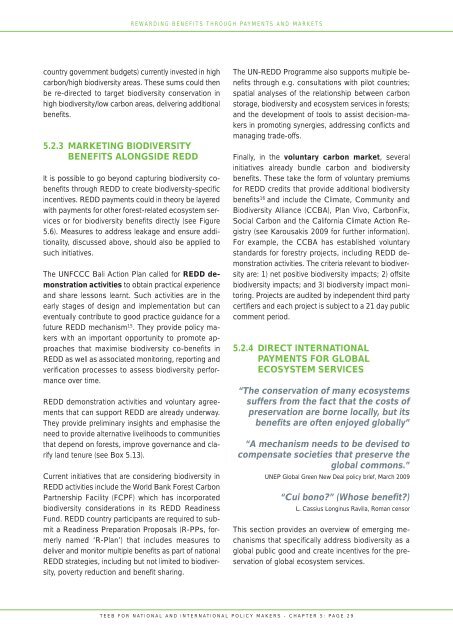Download (PDF, 6.71MB) - TEEB
Download (PDF, 6.71MB) - TEEB
Download (PDF, 6.71MB) - TEEB
You also want an ePaper? Increase the reach of your titles
YUMPU automatically turns print PDFs into web optimized ePapers that Google loves.
REWARDING BENEFITS THROUGH PAYMENTS AND MARKETS<br />
country government budgets) currently invested in high<br />
carbon/high biodiversity areas. These sums could then<br />
be re-directed to target biodiversity conservation in<br />
high biodiversity/low carbon areas, delivering additional<br />
benefits.<br />
5.2.3 MARKETING BIODIVERSITY<br />
BENEFITS ALONGSIDE REDD<br />
It is possible to go beyond capturing biodiversity cobenefits<br />
through REDD to create biodiversity-specific<br />
incentives. REDD payments could in theory be layered<br />
with payments for other forest-related ecosystem services<br />
or for biodiversity benefits directly (see Figure<br />
5.6). Measures to address leakage and ensure additionality,<br />
discussed above, should also be applied to<br />
such initiatives.<br />
The UNFCCC Bali Action Plan called for REDD demonstration<br />
activities to obtain practical experience<br />
and share lessons learnt. Such activities are in the<br />
early stages of design and implementation but can<br />
eventually contribute to good practice guidance for a<br />
future REDD mechanism 15 . They provide policy makers<br />
with an important opportunity to promote approaches<br />
that maximise biodiversity co-benefits in<br />
REDD as well as associated monitoring, reporting and<br />
verification processes to assess biodiversity performance<br />
over time.<br />
REDD demonstration activities and voluntary agreements<br />
that can support REDD are already underway.<br />
They provide preliminary insights and emphasise the<br />
need to provide alternative livelihoods to communities<br />
that depend on forests, improve governance and clarify<br />
land tenure (see Box 5.13).<br />
Current initiatives that are considering biodiversity in<br />
REDD activities include the World Bank Forest Carbon<br />
Partnership Facility (FCPF) which has incorporated<br />
biodiversity considerations in its REDD Readiness<br />
Fund. REDD country participants are required to submit<br />
a Readiness Preparation Proposals (R-PPs, formerly<br />
named ‘R-Plan’) that includes measures to<br />
deliver and monitor multiple benefits as part of national<br />
REDD strategies, including but not limited to biodiversity,<br />
poverty reduction and benefit sharing.<br />
The UN-REDD Programme also supports multiple benefits<br />
through e.g. consultations with pilot countries;<br />
spatial analyses of the relationship between carbon<br />
storage, biodiversity and ecosystem services in forests;<br />
and the development of tools to assist decision-makers<br />
in promoting synergies, addressing conflicts and<br />
managing trade-offs.<br />
Finally, in the voluntary carbon market, several<br />
initiatives already bundle carbon and biodiversity<br />
benefits. These take the form of voluntary premiums<br />
for REDD credits that provide additional biodiversity<br />
benefits 16 and include the Climate, Community and<br />
Biodiversity Alliance (CCBA), Plan Vivo, CarbonFix,<br />
Social Carbon and the California Climate Action Registry<br />
(see Karousakis 2009 for further information).<br />
For example, the CCBA has established voluntary<br />
standards for forestry projects, including REDD demonstration<br />
activities. The criteria relevant to biodiversity<br />
are: 1) net positive biodiversity impacts; 2) offsite<br />
biodiversity impacts; and 3) biodiversity impact monitoring.<br />
Projects are audited by independent third party<br />
certifiers and each project is subject to a 21 day public<br />
comment period.<br />
5.2.4 DIRECT INTERNATIONAL<br />
PAYMENTS FOR GLOBAL<br />
ECOSYSTEM SERVICES<br />
“The conservation of many ecosystems<br />
suffers from the fact that the costs of<br />
preservation are borne locally, but its<br />
benefits are often enjoyed globally”<br />
“A mechanism needs to be devised to<br />
compensate societies that preserve the<br />
global commons.”<br />
UNEP Global Green New Deal policy brief, March 2009<br />
“Cui bono?” (Whose benefit?)<br />
L. Cassius Longinus Ravilla, Roman censor<br />
This section provides an overview of emerging mechanisms<br />
that specifically address biodiversity as a<br />
global public good and create incentives for the preservation<br />
of global ecosystem services.<br />
<strong>TEEB</strong> FOR NATIONAL AND INTERNATIONAL POLICY MAKERS - CHAPTER 5: PAGE 29

















